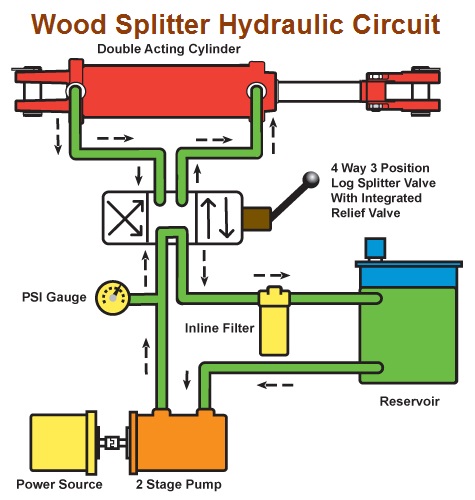Hydraulic Wood Splitter
Cycle Time and Force Calculators
Log Splitter speed (the cycle time to split a log and return to the start position) is determined by the volume of fluid flow, or gallons per minute (GPM).
To increase the speed of a log splitters operation, a bigger hydraulic fluid pump is required to pump more volume of hydraulic fluid.
However, upgrading a hydraulic pump may also require you to increase the size of your hydraulic tank to prevent overheating the hydraulic fluid.
In turn, you may need to increase the size of your hydraulic hoses to accommodate the increased flow of hydraulic fluid.
Plus, you may be required to increase the size of your power plant (engine) to drive the bigger pump. Oh My!

|
Increasing Log Splitter Return Stroke Speed
If your desire is simply to just increase the return stroke speed, you can just replace the hydraulic cylinder with one that has a larger push rod diameter. This decreases the volume of fluid between the rod and the bore so that less fluid is required to retract the cylinder. This can effectively speed up the return stroke of you wood splitter.
Another way is to use a 2 stage hydraulic pump
Two stage hydraulic pumps operate in 2 modes. When there is no load (on the return stroke), it pumps a larger volume at low pressure and moves the ram back quickly. When the ram hits the wood the pressure increases and the pump switches to hi pressure / low flow mode. A two stage pump speeds up the whole cycle process due to the fact that 3/4 of the time the ram is moving with little or no load, which requires less power or less force to move the splitting ram. Optionally, there is also a 3 way valve solution that may be a better fit.
How 2 Stage Hydraulic Pumps Work
If you've ever wondered how a 2 stage pumps work, here's what's inside! There are generally 2 gear pumps running in parallel. One of them includes a spring-loaded pop-off valve that opens up at higher pressure (300 psi +- adjustable). This disables one of the pumps. If the valve is stuck or leaking, you effectively have a single-stage pump. This will cause the splitter operation to be S.L.O.W.
Hydraulic Log Splitter Speed & Cycle Time Calculator
You can calculate the cycle time of your wood splitter to determine how long it takes to extend for splitting the log and then return to its starting position. Do this with the calculator below by entering the gallons per minute rating on your hydraulic pump, and the bore, stroke, and rod size of your hydraulic cylinder.
Implementing a 3-Way Valve For Faster Cycle Time
Another way to speed up your log splitter is by applying a little-known trick that involves adding a 3-way valve (i.e. 3-port, 2-position valve). This action will only speed up the forward stroke, as it reduces the splitting force proportionately.
The extra valve has a "common" port that "depending on which way the control leaver is set", connects to one or the other of the ports. This common port is what connects to the ROD end of the cylinder.
One of the remaining valve ports is connected to the line that previously went directly to the rod end of the hydraulic cylinder. The other port is spliced into the line feeding the BASE end of the hydraulic cylinder with a tee fitting.
With the auxiliary valve set in position one, the cylinder operates normally as originally intended under both the forward and backward strokes.
 When
the auxiliary valve is moved to position two, the cylinder only operates
on the forward stroke. This supplies pressure to BOTH ends of the cylinder
simultaneously as one side exerts less force (because the rod occupies
part of the surface area) so the cylinder still extends. Simultaneously
the fluid forced out of the rod end circulates back to the base end.
This increases the rate at which the cylinder moves through the splitting
stroke.
When
the auxiliary valve is moved to position two, the cylinder only operates
on the forward stroke. This supplies pressure to BOTH ends of the cylinder
simultaneously as one side exerts less force (because the rod occupies
part of the surface area) so the cylinder still extends. Simultaneously
the fluid forced out of the rod end circulates back to the base end.
This increases the rate at which the cylinder moves through the splitting
stroke.
In this position with both ends of the cylinder linked together and pressurized, you are operating the cylinder in single-action mode with fluid operating the diameter of the rod, rather than the diameter of the piston.
To operate: Set the auxiliary valve to position 2 and set the main valve to extend the cylinder. If the splitter starts to bog down, switch the auxiliary valve back to position 1 for normal operation. The auxiliary valve must be in position 1 to activate the retract mode and return the cylinder to start position.